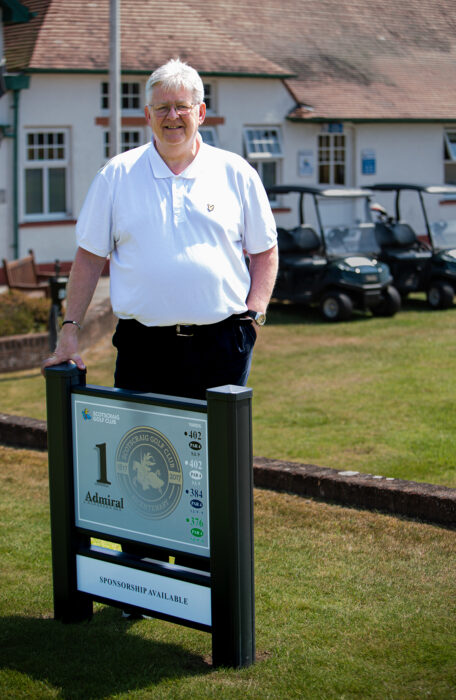Meet the general manager: Liam Greasley
The general manager of Scotscraig Golf Club near St Andrews talks to Magna Marketing’s CEO, Jonathan Ellenor, about modernising the governance of the club, reintroducing a joining fee, becoming a living wage employer and adopting a new marketing approach.
Scotscraig Golf Club, situated just ten miles from St Andrews, is a historic institution at the intersection of tradition and innovation. The club has embarked on a mission to revolutionise its identity, governance and operations and, in doing so, has showcased how strategic alignment and an external agency can rejuvenate a venerable club, demonstrating that even historic establishments can thrive in the modern golf landscape.

Liam Greasley
What is your career path to the manager of Scotscraig?
I left Scotland back in 1987, right after qualifying as a PGA golf professional. My first stop was the Emirates Golf Club in Dubai, where I worked as a teaching pro. After about three years there, I decided to return to the south of England, taking up the role of director of golf at Dale Hill Hotel & Golf Club in East Sussex, which was the site of Ian Woosnam’s first course design.
I then moved to the Drift Golf Club in Surrey also as director of golf, becoming general manager in 2001. Eight years later, I joined the PGA as manager of what is now the PGA in England South and over time moved up the ranks to become the PGA director of regions and membership and eventually commercial director.
In 2020, I shifted gears a bit and became chief executive of an environmental start-up called Green Club, delivering environmental solutions. Although not directly linked to golf operations, it kept me connected with the golf industry. During this time, I decided to move back to Scotland, a decision that brought me full circle, back to where it all started.
What insights did your initial deep dive into Scotscraig reveal?
When I was first introduced to Scotscraig, the club was in search of a manager. Even though my knowledge of the golf club was quite limited, their vision was immediately clear: they sought to establish a resilient foundation for their golf club in the post-Covid era. Given the challenging economic climate everyone was grappling with, this was no minor task. So the brief simply was to enhance the club’s resilience and secure its future amidst these trying times.
My initial strategy was a comprehensive assessment of the club’s operations, structure and history. With a remarkable legacy and an impressive 6,698 yard, par 71 golf course, Scotscraig holds a fantastic position in the industry. Its credentials were further enhanced by hosting prominent tournaments including the Open and Senior Open Championship qualifying, the Rose Series and the European Girls and Boys Amateur Team Championships.
To be frank, over time, both on and off the course, the club had become somewhat outdated. As is common with many traditional members’ clubs, it was grappling with governance issues. Compounding the problem was the stagnation of membership fees, which had not kept pace with inflation or operational costs. Consequently, the expenses of running the club were increasingly becoming unsustainable, signalling a critical need for modernisation and financial restructuring. I felt it was crucial to consider the overall cost structure, whether it pertained to membership fees or visitor charges.
Scotscraig has an enviable position just 10 miles from St Andrews and a short drive from Carnoustie in the other direction. Yet, paradoxically, it had been struggling with stagnant revenues for many years in part due to a fixed membership and visitor fee rates. This economic standstill resulted in constricting profits, which has further impacted the scope for necessary reinvestment in infrastructure, essential equipment, course maintenance and personnel.
The repercussions have been stifling, making the delivery of a top-tier golfing experience a formidable challenge. The deteriorating condition of the course was quickly losing its appeal to members and visitors alike, significantly undermining the revenue potential from a crucial sector, the golf travel market.

Over time the course started showing signs of fatigue, but commendably, head greenkeeper, Darren McKenna, and his team have amazingly reversed this trend through supreme dedication and ingenuity against the backdrop of very limited resources. The challenge now became to leverage the course’s improved state and prime location to reassess our pricing strategy, stimulate financial growth and deliver a premium golfing experience.
Concluding that revising fees for both members and visitors could invigorate the club’s profit margins, we aimed to ensure the continuous upkeep and improvement of the course. This strategic move allowed us to unlock our revenue potential and establish a sustainable path towards delivering an exceptional golfing experience.
It was crucial, then, to seriously consider a significant adjustment in the green fee price, which had remained roughly at £80 for the past seven years. By seizing this opportunity, the club could capitalise on the inbound visitor traffic and unlock a substantial benefit, helping us to fully realise our club’s financial potential.
Alongside these initial changes the other big elephant in the room was the governance issue facing the club as a traditional member owned and managed club.
Tell us more about the journey to incorporation?
As an unincorporated body, every member is liable for a share of any liability the club faces. This puts the club at considerable risk, especially in a downturn. What if an undervaluation of the club property occurs, and someone makes an offer way below its perceived worth? In the most extreme circumstances, Members might feel sufficient pressure to accept a low offer.
That’s why the idea of incorporation cannot be stressed enough. In an incorporated club, a limited company runs the business on behalf of the members. This structure safeguards members from direct liabilities and offers a better platform for crisis management. If anything happens to the day-to-day running of the club, the limited company carries the risk, while the members retain ownership of the property.
Workforce investment and professional staffing are other important considerations. A well-staffed club not only offers superior services but also allows you to focus on strategic planning and adapting to market trends.
The changing landscape of golf club management requires a shift in perception. Today, clubs need to think more like businesses, with a focus on strategic planning, professionalisation and financial structuring.
Traditional club management, with a secretary or manager acting predominantly as a facilitator of the council’s wishes, has limitations. From the outset, I questioned this model’s ability to sustain the club’s growth and improvement. Thankfully, my concerns were validated, and I found that a more dynamic approach to managing day-to-day business has resulted in significant improvements.
This shift in approach has significantly alleviated pressure on our elected council. While council membership requires significant commitment and a deep emotional connection to the club, these qualities alone may not equip council members with the necessary skills to navigate our industry’s evolving landscape.

Scotscraig GC
That’s why I believe it’s essential for golf clubs to consider transitioning towards a model where a managing director or CEO is responsible for delivering the club’s aspirations. At Scotscraig, our council is focused primarily on the golfing and social activities at the club as opposed to the day to day running of the business.
Making the transition to a living wage employer was one of the first significant changes I implemented. In a region where living wage employers are rare, this decision set us apart and allowed us to attract a more professional, career-focused team and address the challenges of often short-term employment.
When reviewing the membership fee structure for the 23/24 season, we implemented an across-the-board 10 percent increase. Additionally, we reintroduced a membership joining fee. This wasn’t a decision made lightly; our goal was to tackle the issue of transitory memberships where membership is a revolving door with little or no loyalty. A challenge that’s common in regions where the appeal of golf clubs can fluctuate based on price, desperation and the condition of the courses year-on-year.
This pattern doesn’t support a sustainable or reliable business model. At Scotscraig, we are trying to build a consistent and dedicated member base. We want individuals to join our club for the right reasons – not just for the state of our greens or fairways.

What prompted you to bring in Magna Marketing as an outside agency into the club?
Our decision to engage Magna Marketing as our external agency was spurred by the need for significant transformation within our business. Primarily, we were contending with a reputational challenge due to the course’s previous sub-optimal conditions. To regain the trust of our members and the wider golfing community, we recognised the need for expert assistance to rebuild our image.
We also braced ourselves for a potential membership decline following a fee increase. To offset this, it was crucial to infuse new life into our member base through strategic and targeted marketing, attracting fresh members to our club. Most importantly, we aspired to effectively communicate our evolving narrative and value proposition.
From the beginning, Magna Marketing understood the challenges we faced, acknowledging the financial constraints that dictated an organic process over a paid advertising approach.
Together, we shaped a message tailored to our three target audiences – tour operators, potential new members and corporate partners. We aimed to position Scotscraig as a viable alternative for those playing the traditional St Andrews, Kingsbarns, Dumbarnie and Carnoustie circuit. Moreover, we sought to convey that Scotscraig was on the rise, appealing to the local, national and international markets. Jon devised a simple but effective way to frame this message – ‘History, Challenge, and Experience’. To incentivise tour operators, we carefully restructured green fee rates, offering a more substantial margin on each booking.

Another crucial aspect was Scotscraig’s need to project its continuous improvements to a larger audience, extending beyond the local scene to the national level within Scotland, the rest of the UK, and overseas. Magna applied an agile and dynamic approach to accomplish this, initiating an influential PR and media campaign across multiple channels.
In a short period, Scotscraig started ranking consistently among Scotland’s top three golf venues for digital promotions. This upward shift in the market was pivotal, and really set us on the path we continue to follow today. The journey demanded regular, clear communication, maintaining a consistent tone and language, and upholding high standards of presentation. These elements started to seep through all aspects of the club’s operations, raising the bar in every regard.
No matter the current position, it was essential to recognise the unique value and appeal of Scotscraig as a brand. Although we haven’t reached our aspiration yet, every step is aimed at achieving this future objective. Collaborating with Magna, we began reshaping perceptions of Scotscraig, leading the pack instead of following.
The surge in bookings from individuals and groups, domestically and internationally, is a heartening indicator of our efforts. This upswing, which amounts to approximately a 30 percent increase, not only boosts our brand visibility across varied markets, but also significantly strengthens our revenue stream.

What else has the club done and achieved this year aside from the marketing and governance aspects?
This year, we’re advancing our standing by hosting the Loch Lomond Whiskies’ PGA Scottish Professional Championship. Hosting the PGA Scottish Professional Championship marks a significant milestone for us. It’s an excellent opportunity for engagement with the wider golf community and for us to benchmark our club against others in Scotland. But perhaps most importantly, this event sends a clear message – Scotscraig is back to its best.
A notable breakthrough for us has been our collaboration with Scotland’s leading female golfer, Gemma Dryburgh. Given that a large segment of our target audience is based in the US, and Gemma competes on the LPGA tour, this partnership aligns perfectly with our strategic goals.
As our club ambassador, Gemma proudly displays our logo on her golf bag. This partnership, despite the geographical distance, has significantly enhanced our visibility, particularly in the US market.
Our new restaurant, Braids at Scotscraig, represents a significant evolution of our clubhouse, paying tribute to James Braid, one of our course’s original architects. This venture brings together our rich golfing heritage and culinary excellence, offering a unique dining experience enriched by historical artifacts.
More than just a restaurant, Braids introduces a valuable revenue stream and expands our service range, enabling us to host various events from conferences to weddings. Embodying our sustainability and community commitment, the restaurant partners with Tayport Distillery for locally crafted drinks and emphasizes local ingredients

What are your aspirations for the club’s development and progression in the upcoming years?
Scotscraig’s core mission is to deliver exceptional services and facilities to members and visitors. Our strategic vision involves incorporation for financial security and sustainability. We aim to reinvest in our infrastructure and facilities, promoting growth.
While honouring our heritage, we adapt to the future. Golf is dynamic, and so are we. This year marked the start of an exciting journey, guided by James Braid’s timeless advice: “Keep on hitting it straight until the wee ball goes in the hole.”















Great article, love the modern approach, having been friends with Liam for over 30 years I can honestly say this wee man can definitely deliver … Great work mate !
I love the fully rounded approach and the emphasis on continuous improvement. Well done , great model and exemplar.
Excellent article Liam Greasley True leadership , thinking of the future
Great news. Superb course and I’m sure you’ll take it to the next level.
No one knows the business better than Liam.
Great course which I first played many many years ago….when Tony Gilbert was the pro.
Brilliant article , Liam . Well done . When it comes to golf “you are da man” ….
Love this golf course, amazing setting and a tricky PAR 4 to start! Well done
Big man knows the script